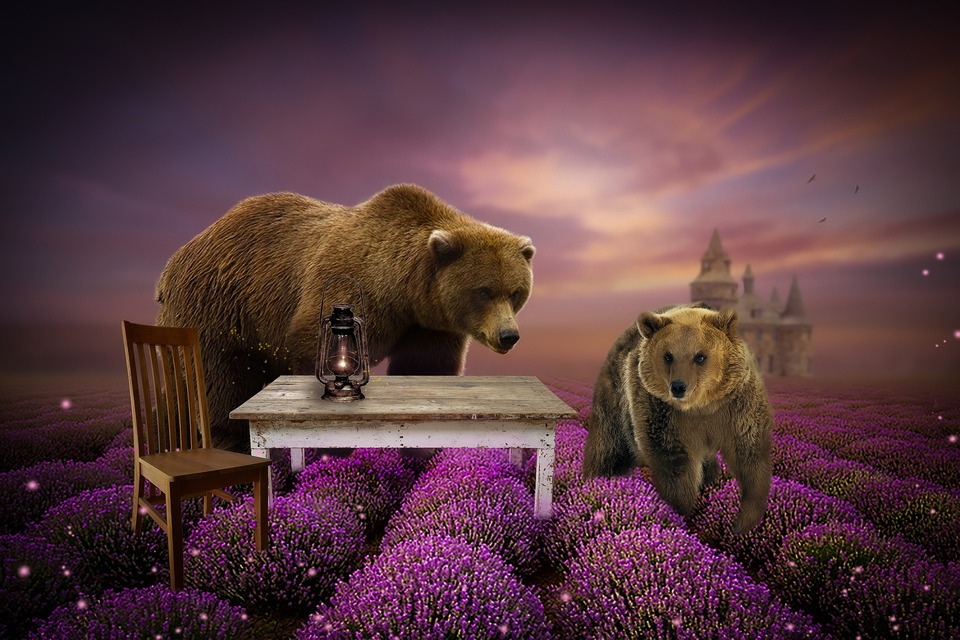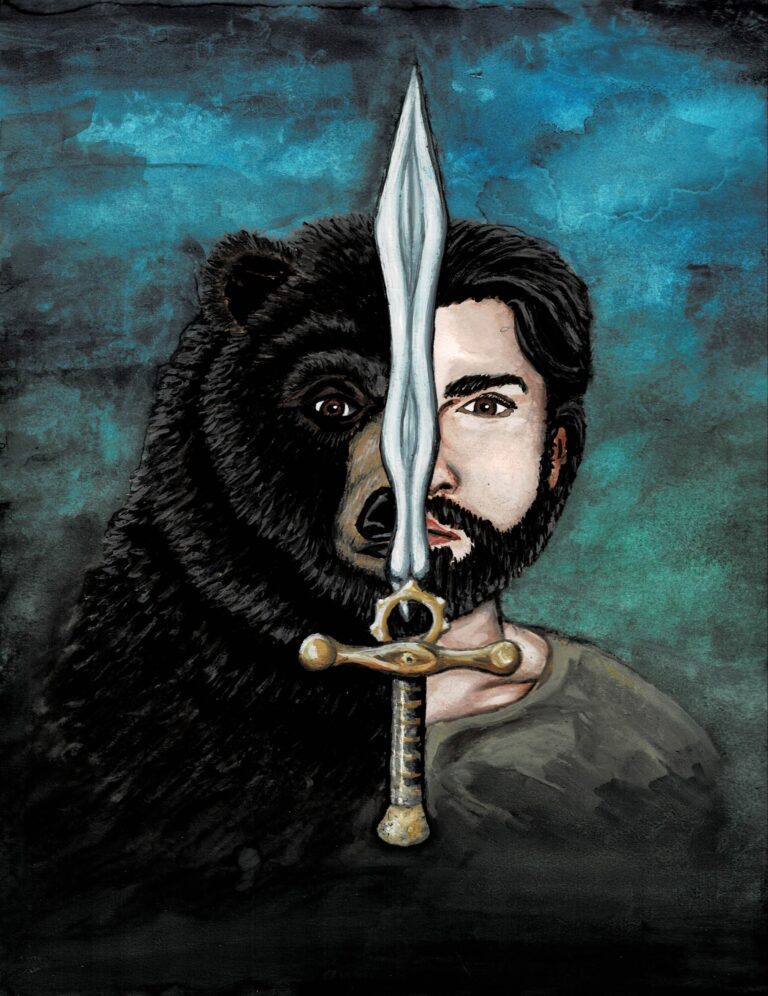Writing Bears into Fantasy
Part 1

If you told me one day I’d wake up and write an entire novel based of bears, I’d probably laugh. Don’t get me wrong. Bears are cool, but they aren’t my favorite animal, nor did I have any particular fascination with bears. So what led me to write a novel based off of bears? It’s really pretty simple and little ridiculous. One early morning around four, I was awakened by a vivid dream… about bears.
Like most dreams, it didn’t make a whole lot of sense, but it did get my imagination wheels spinning—fast. It bugged me and wouldn’t leave me alone. Characters were screaming in my head to tell their story, and before long I had a 99,000 word rough draft. (It has now morphed into an 114,000 word novel.) During this time if anyone had checked my google search history, they might have thought I had a strange fascination for bears.
🌳🐻🏰
The story, Hidden Knight: A Novel of a Bear, takes place in a world inhabited by humans and intelligent bearfolk. By our standards, they would be medieval-like as far as their technology and standard of living is concerned. After hundreds of years of violent warfare, the humans, known on that world as Enoshites, and the bearfolk, called Berardians, learned to peacefully coexist. They established the Kingdom of Adalbern headed by two rulers: an Enoshite King and Berardian Knight.
“In the Kingdom of Adalbern,” Abel explained. “We have joint rulers. The Knight isn’t just any knight, but a Berardian ruler, sworn to protect the King, an Enoshite. Together they unite and rule the people of Adalbern. So it has kept peace for nearly five hundred years.”
“And yet it only takes thirteen years of absence for that peace to be undone,” Kelem said. “Seems peace is fragile.”
But there were others not so happy about this alliance. The bearfolk of Southern Berardia, who disdain humans as inferior creatures, would have little to do with the Berardians of Adalbern beyond trade. And deep within the marshlands, an ancient being bided his time, growing a serpentine army and waiting for an opportune moment to attack. When that first sudden attack came, it nearly brought down the kingdom, sending their heirs of the kingdom into exile on Earth and sowing disunity among the citizens of Adalbern. This is where the story begins.

You can read more about Hidden Knight: A Novel of a Bear under Books.
After brooding over my strange dream for about three weeks, I began writing. At this time I wasn’t really considering publishing and hadn’t told anyone I was writing a book—I didn’t even know if it would be a book. This freedom allowed my imagination to run wild. I took elements from my dream—a small group of friends on Earth suddenly sucked into a portal that whisked them past stars and galaxies before plopping them down on a planet, a man that changed into a bear much to his own surprise, and giant armored bears attacking a village—and begin forging it into something that made sense. I had a lot of questions to answer. Who created a portal and why? How did the man not know he was a bear and why did the portal change him? And why were great armored bears attacking human villagers with swords and axes?
It turned out that writing bears into fantasy was a lot of fun. Since it was fantasy, I had the liberty to make the Berardian bearfolk as much—or as little—like real Earth bears as I desired and as suited the story.
Appearance & Physiology
Without armor or cloak, Berardians might be mistaken for a normal bear. If a Berardian considers you a friend, they might greet you with a literal bear hug; but don’t think for a moment that they are cuddly folk. They enjoy feasting and fighting with equal vigor. They have formidable strength that combined with teeth and claws pose a serious threat to any human. Add to that intelligence, cunning, and the ability to wear armor and wield weapons, and you face a terrifying foe if you are unfortunate enough to make them your enemy. It’s little wonder that many humans fear and distrust them, yet if you took a moment to look deeper, you might be surprised at how alike they are to us.
At first glance, he was like any bear, yet closer observation revealed subtle differences. For one, he had opposable thumbs allowing him to grasp his spoon. This was not much help as it was comically too small for his paws or his mouth to make eating with it practical. Beau slammed the spoon down and glanced up, catching her watching him. That was when Chloe noticed it was the facial expressions around his eyes and mouth that conveyed human-like emotions—currently embarrassment.
Some differences to Earth bears, such as opposable thumbs, were necessary to make things like grasping weapons possible for the Berardians. They are also capable of walking upright with great ease and only resort to all fours if running or for greater stability. I don’t go into great depths to explain the Berardians exact anatomy as this is fantasy not sci-fi. After all, no one ever questions how Mrs. Beaver in The Lion, the Witch, and the Wardrobe manages to operate a sewing machine.
As far as bearfolk’s internal organs go, we’re going to assume they are fairly the same as Earth bears. I took the time to research a little into hunting bears with both bows and guns. Not that I personally have any desire for that sort of sport, but because those were the types of weapons the Berardians may face in a violent encounter with a human. One interesting thing I learned is that attacking a bear head on isn’t the wisest as their chests are bony and their heart is located farther down along their sides, information that proved useful in the first battle scene of my book.
Hearing gunshots, Beau spotted Kelem firing at a charging bear. Whether Kelem’s shots had missed or simply failed to slow the bear, Beau did not know. Kelem whipped out his baton, and Beau barreled into the bear moments before he reached Kelem. The bear, though disarmed, overpowered Beau, who staggered back as the bear sunk teeth deep into his neck. Beau raked a claw across the bear’s face, trying to free himself when the bear stumbled and fell—a well-placed arrow from Abel deeply embedded in his side.
There are apparently a lot of misconceptions about bears. That they are slow, or cannot run downhill, that grown bears can’t climb trees, and they have poor vision. All of these are untrue, and I had ample opportunity to display real facts about bears through the Berardians. I wanted my bearfolk to be bears foremost—yes, intelligent and advanced, but not simply folk that look like bears.
With a backward glance, Kelem saw Beau was starting to lag behind. Anyone that thought of bears as being slow had never witnessed one in a full charge. Over short distances they could run nearly as fast as a horse. Furthermore, Berardian warriors were well conditioned to long treks. But Beau was unused to such physical exercise, so Kelem had urged his uncle to keep their pace slow.
“Hold up,” Kelem said. “I think it’s time for a break.”
Beau caught up, huffing. “This is gonna kill me.”
“This horse is going to kill me,” Kelem said, stretching after he dismounted. He didn’t remember horseback riding being so painful.
Vocalizations
Staying true as possible to actual bear vocalizations really made the Berardians come alive. Now obviously Earth bears can’t speak, but I loved to express the Berardians speech through bear-like sounds. I know, in writing it’s recommended to keep dialogue tags simple, and generally I would agree, but when it came to the bearfolk, I felt this “rule” needed to be stretched a little. Bears grunt, bears huff, bears snarl, and polar bears chuff (which was my favorite to use for Eirwen when she was annoyed). I balanced this by keeping the humans’ dialogue tags simple to nonexistent.
One thing bears don’t do, at least black bears, is growl. I thought this was interesting. Sometimes polar bears or brown bears are described as “growling,” but it’s really up to the interpretation of the listener. It’s nothing like a dog’s growl, and I would describe it more as a snarl. But it’s generally agreed on among the various nature websites that black bears don’t growl. They don’t even really roar. Berardians aren’t divided into the categories of Earth species, but since Beau is described as a “black bear” I kept his vocalizations in line with real black bears. The only growling Beau does is in his stomach.
Black bears may clack their teeth, chomp, and blow when startled or frightened or ready to retreat. Beau starts out very unsure of himself, so I established this habit of him clacking his teeth when anxious early on in the novel. Another sound a black bear might make is “popping” by bringing air through their teeth and cheeks. It’s a sound of warning to enemies as well as cubs. This is too fun a sound for me not to find occasion to use it in my novel.
Beau clacked his teeth and kept a wary eye on the general. He wanted nothing to do with the large bear or any of his people. It was like a bizarre dream in which no one but the dreamer seems to realize that things are not as they should be.
“Sir,” General Argo said, “Your people need you.”
“My people?” Beau said, “I don’t even know my people.”
“Sir Beauregard, you will never know your people if you continue to ignore them.”
“Seems I was sent away.”
“That wasn’t my idea.” The general snapped his jaws with a loud pop.
My favorite of all bear sounds though are the vocalizations which black bears use during a fight. It’s like nothing you ever hear in a movie. Movies depict bears making the sounds people want to hear rather than the actual sounds bears make. In the video linked below, two male bears are vocalizing while fighting over a female. It’s a hard sound to describe, but it almost sounds like they’re talking and arguing. I can imagine one saying, “Hey dude, this is my girl. Get lost.” I don’t use this strange sound in my novel, partly because I’m not sure how to describe it, and also because Berardians actually do speak. I like to imagine that maybe Berardians would understand what these bears are saying.
(Fight starts at 1:45. The vocalizations begin at 2:02.) Video: https://bear.org/do-black-bears-growl/
I realize my post is getting long, so stayed tuned till the next post, and I’ll continue with the Customs and Culture of the Berardians.

I love it! A fun read.
Thank you for reading!
Pingback: Writing Bears into Fantasy Part 2 - Leanna Rapier
Pingback: Why I Include Magic in my Fantasy Part 4 - Leanna Rapier